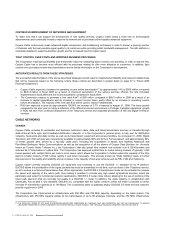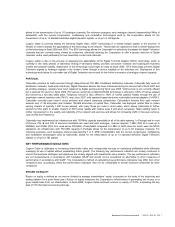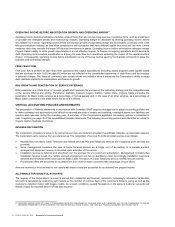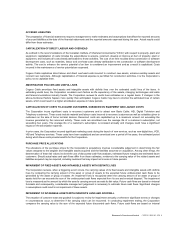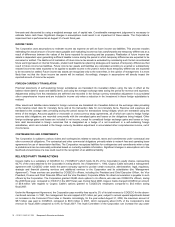Cogeco 2008 Annual Report Download - page 16
Download and view the complete annual report
Please find page 16 of the 2008 Cogeco annual report below. You can navigate through the pages in the report by either clicking on the pages listed below, or by using the keyword search tool below to find specific information within the annual report. Management’s Discussion and Analysis COGECO CABLE INC. 2008 15
to basic and pay services of cable operators, likely starting in 2009. Sonaecom owns and operates the Clix (Residential Fixed
Telephony, HSI and IPTV), Novis (Business Telephony Solutions) and Optimus (Wireless Telephony and Wireless HSI) services,
which provide voice, data, HSI, video and mobile services to the residential and business markets. Cabovisão, Zon, PT and
Sonaecom all have competitive triple-play offers available in the Portuguese market. Cabovisão is pursuing the rollout of a Digital
Television service in order to improve signal security and quality, provide an expanded choice of programming, make better use of
the distribution capacity of its network and better compete with the digital television service offerings of its competitors, but this new
Digital Television service is less penetrated than that of its competitor Zon. The competitive television service offerings of the other
competitors are all Digital.
The level of piracy of television signals and the actual penetration of illicit reception of television distribution services in households
within the Corporation’s service areas may also have a significant effect on the Corporation’s business and the competitiveness of
its service offerings.
TECHNOLOGICAL RISKS
The evolution of telecommunications technologies unfolds at breathtaking speed, fuelled by a highly competitive global market for
Digital content, consumer electronics and broadband products and services. The Corporation continues to monitor the development
of technologies used for the transmission, distribution, reception and storage of data and their deployment by various existing or
potential competitors in the broadband telecommunications markets.
There are now several terrestrial and satellite transmission technologies available to deliver a range of electronic communications
services to homes and to commercial establishments with varying degrees of flexibility and efficiencies, and thus compete with cable
telecommunications. On the other hand, cable telecommunications also continue to benefit from rapid improvements, particularly in
the areas of modulation, digital compression, fractioning of optoelectronic links, multiplexing, HD distribution and switched video
distribution.
Management of the Corporation remains of the view that broadband wireline distribution over fibre and coaxial cable will continue to
be an efficient, reliable, economical and competitive platform for the distribution of a full range of electronic communications
products and services for the foreseeable future. The competitiveness of the cable broadband telecommunications platform will
however continue to require additional capital investment on a timely basis in an increasingly competitive and uncertain market
environment.
The growth in penetration of broadband connections of all types, the rapid increase in transmission speeds offered by competitors in
the market and the deployment of the more powerful and efficient MPEG-4 video compression standard and of other similar
compression technologies promote the increased distribution and consumption of video content directly over the Internet. This may
eventually lead to fragmentation of the retail market for existing Analogue and Digital Television distribution services provided by the
Corporation and gradual disintermediation through direct transactions between video content suppliers and the Corporation’s
customers. In this context, revenue and margins derived from the Corporation’s HSI access services may not entirely compensate
for the loss of revenue or margin derived from the Corporation’s Television services in the future. Alternative voice and data
communications services are proliferating over the Internet, resulting in the risk that fragmentation and disintermediation may also
occur in the future with respect to the Corporation’s Telephony service.
Electronic communications increasingly rely on advanced security technology, devices, control systems and software to ensure
conditional access, appropriate billing and service integrity. Security and business systems technology is provided worldwide by a
small pool of global suppliers on a proprietary basis. As other providers of electronic communications, the Corporation depends on
the effectiveness of such technology for many of its services and the ability of technological solutions providers to offer cost-effective
and timely solutions to deal with security breaches or new developments required in the marketplace.
REGULATORY RISKS
In Canada, electronic communications facilities and services are subject to regulatory requirements depending mainly on the type of
facilities involved, the incumbent status of service providers and their relative market power, the technology used and whether the
activities are categorized as telecommunications or broadcasting. Canadian cable telecommunications facilities and services are
subject to various requirements mainly under federal legislation governing broadcasting, radiocommunication, telecommunications,
copyright and privacy, and under provincial legislation governing consumer protection and access to certain municipal property and
municipally-owned support structures. Licenses and broadcasting certificates are still required for the operation of larger (Class 1
and 2) cable systems, while smaller (Class 3) cable systems are now mostly license-exempt. Various license and license exemption
conditions continue to apply in Canada. Canadian cable telecommunications operators are also subject to Canadian ownership and
control requirements. Changes in the regulatory framework or licenses, which are subject to periodic renewal, may affect the
Corporation’s existing business activities or future prospects. Following a comprehensive review of the regulatory framework for
broadcasting distribution and for pay and specialty television in Canada conducted earlier this year, the Canadian Radio-television



